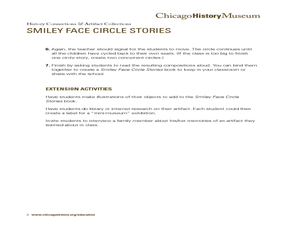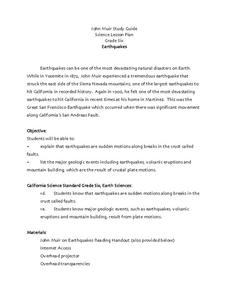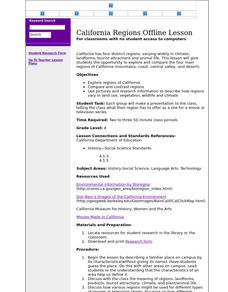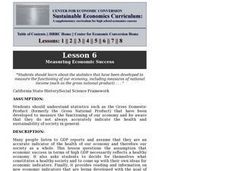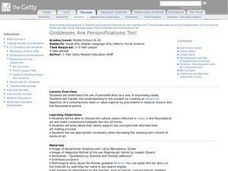Curated OER
The Cause and Course of the Great War
Students interpret historical evidence presented in primary and secondary resources. In this World War I lesson, students research the causes of the war as well as the major events of the war. Students are...
Curated OER
Da Vinci's Renaissance
Students study the Renaissance through an examination of the life and accomplishments of Leonardo Da Vinci.
Curated OER
George Washington and the Rule of Law
students compare The rule of law with the rule of men and consider life under each of these types of governments.In this government lesson, students read a primary source to examine the importance of the rule of law.They will also answer...
Curated OER
My Holiday Portfolio
Students create a holiday portfolio by participating in these three lessons. They experience using the computer by using the provided student guides.
Curated OER
Sculpting a Modern Hero
Students examine the sculpture of the Greek hero Herakles. In this visual arts lesson, students choose a modern hero and create a sculpture that features the hero’s identity and attributes.
Curated OER
Putting a Spin on Current Events
Students explore the artistic value of propaganda. In this visual arts instructional activity, students analyze antique artistic pieces for their political agenda perpetuation. Students discuss propaganda techniques of the past to...
Curated OER
Looking at Ritual and Ceremony
Students explore Edward Curtis' photos of a Native American ritual and practice documenting their own religious rituals. In this photography analysis instructional activity, students analyze an Native American ritual in Curtis' photo....
Curated OER
Vietnam and the Long-Term Effects of War
Students examine the aftermath of war. In this Vietnam War lesson, students consider the implications of war as they analyze the image Siege of An Loc, South Vietnam. Students discuss the causes of the war and the outcome prior to...
Curated OER
The Achievements of the Sumerian Empire
Sixth graders identify four achievements of the Sumerians. They explain the importance of the inventions. They write about a Sumerian invention.
Curated OER
Smiley Face Circle Stories
Students examine different artifacts from the 1970's. In this history instructional activity, students discover what each artifact is by seeing the artifact and reading a card defining what the artifact represents. On the second day,...
Curated OER
Earthquakes
Sixth graders explore reasons for earthquakes. They discuss and describe the types of faults. Using the internet, 6th graders research a specific location of a former earthquake. They describe the damage, magnitude, the epicenter,...
Curated OER
Get to Know Your City
Third graders research the history of their home city and how it's development was influenced by different groups of people. They present their research information to the class.
Curated OER
The Role of Government
Students are introduced to the economic roles of the federal government. Using the internet, they read information related to government spending and the actual dollar amounts attached to budget items. In groups, they develop their own...
Curated OER
California Regions
Pupils explore and compare and contrast the four main regions of California: mountains, coast, central valley, and desert. students use pictures and research to describe how regions vary in land use, vegetation, wildlife and climate.
Curated OER
Fusing Furniture And Asian Art
Students see how French artists used imported lacquer panels in their furniture. They explore Asian lacquer panels and create their own Asian-inspired lacquer panel design. They incorporate their classmates' designs into a new furniture...
Curated OER
The Poetry Of Chinoiserie
Students examine works of art that incorporate Asian export objects, and then respond to them using Japanese haiku poems. discuss the subject and meaning in a work of art. They explain the basic ideas behind Japanese haiku poetry.
Curated OER
Where's My Dot?
Students explore the five basic elements of Monart, dot, curved line, straightline, and angle line to create a book about their home address. The concept of "big" is explored in this lesson.
Curated OER
The Market System and Consumerism
Students examine their own consumption habits. Using various advertisements, they discuss their role in showing consumers what they must have in their lives. As a class, they encourage each other to change their habits and discuss how...
Curated OER
Products, the Environment and Consumer Choices
Young scholars review the factors of production and how they are used to make the products they buy. In groups, they participate in different scenerios in which they discover the amount of power they have to affect change buy purchasing...
Curated OER
Business Practices and Competition
Students identify the costs and benefits of large corporations and monopoly industries. Using the internet, they discover how businesses use different types of exploitation to maximize their profits. They read two articles about plants...
Curated OER
Measuring Economic Success
Students are introduced to the Gross Domestic Product and what this number tells us about the economy of the United States. In groups, they discuss what constitutes a healthy society and if the GDP is an accurate representation. They...
Curated OER
How the Great Depression Affected California and C¿¿sar E. Ch¿¿vez
Fourth graders examine the effect of the Great Depression on California. After reading a summary, they discover how the depression and Dust Bowl led to the immigration of great numbers of farm workers into California. They also...
Curated OER
Imaginative Minds
Eighth graders study the lives and creations of several significant inventors as well as designing their own invention and submitting it to a mock patent process. They determine the importance of notable inventions and their impact on...
Curated OER
Goddesses are Personifications Too!
Young scholars analyze the use of personification in classical Greek art and the Neoclassical period. In this Neoclassical art lesson, students discuss the cultural values reflected in classical and Neoclassical. Young...









